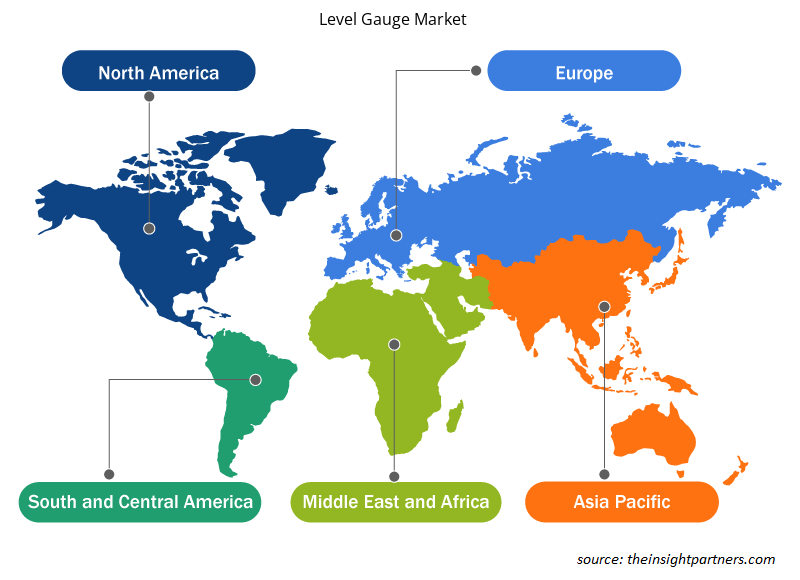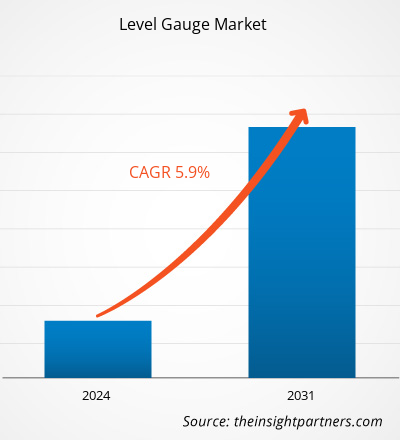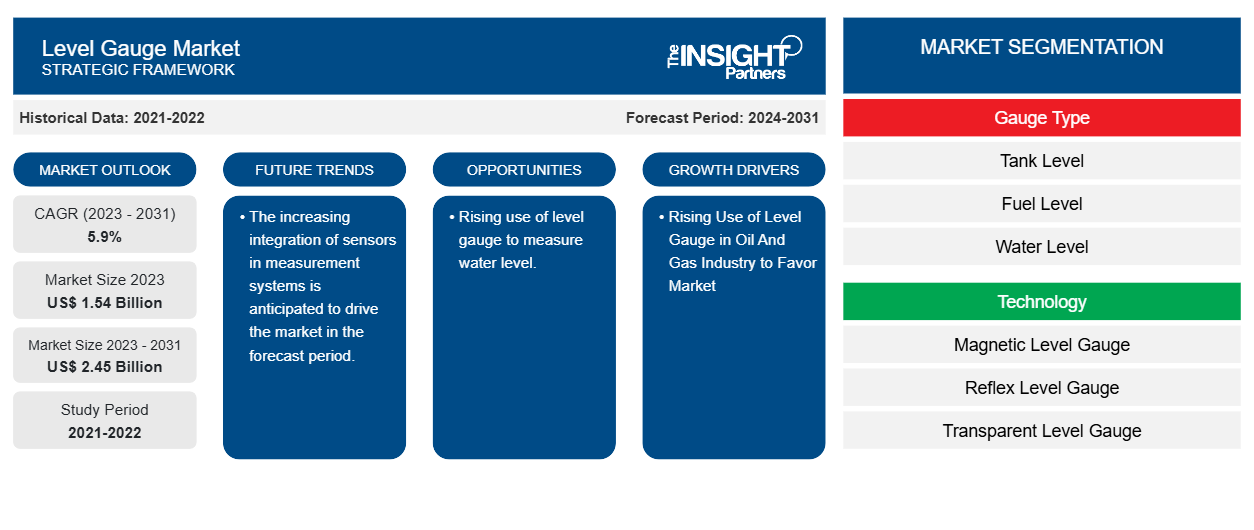Der Markt für Füllstandsmessgeräte soll von 1,54 Milliarden US-Dollar im Jahr 2023 auf 2,45 Milliarden US-Dollar im Jahr 2031 anwachsen. Der Markt soll zwischen 2023 und 2031 eine durchschnittliche jährliche Wachstumsrate (CAGR) von 5,90 % verzeichnen. Die zunehmende Verwendung von Füllstandsmessgeräten in der Öl- und Gasindustrie und der zunehmende Einsatz automatischer Tankmesssysteme dürften weiterhin wichtige Trends und Treiber des Marktes bleiben.
Marktanalyse für Füllstandsmessgeräte
Der Markt für Messgeräte verzeichnet weltweit ein deutliches Wachstum. Dieses Wachstum ist zurückzuführen aufdie zunehmende Verwendung von Füllstandsanzeigen in der Öl- und Gasindustrie und der zunehmende Einsatz automatischer Tankmesssysteme. Darüber hinaus wird erwartet, dass die zunehmende Verwendung von Füllstandsanzeigen zur Messung des Wasserstands und die Integration von Sensoren in Messsysteme das Marktwachstum in den kommenden Jahren vorantreiben werden.
Marktübersicht für Füllstandsmessgeräte
Füllstandsanzeiger sind Mess- und Sensorgeräte, die zur Überwachung des Flüssigkeitsstands in Tanks oder anderen Lagerbehältern verwendet werden. Diese Instrumente werden häufig in industriellen Prozessanwendungen verwendet, um Flüssigkeitsstände in Tanks, Fässern, Druckbehältern und anderen ähnlichen Anwendungen zu überwachen. Der Anzeiger besteht aus mehreren Teilen, darunter einem Kopf, einem Schwimmer, einem Maßband, einer unteren verankerten Halterung, Führungsdrähten, Winkelstücken, Ankern, einer Kupplung, Rohrhalterungen und Rohrleitungen.coupler, pipe support brackets, and pipework.
Passen Sie diesen Bericht Ihren Anforderungen an
Sie erhalten kostenlose Anpassungen an jedem Bericht, einschließlich Teilen dieses Berichts oder einer Analyse auf Länderebene, eines Excel-Datenpakets sowie tolle Angebote und Rabatte für Start-ups und Universitäten.
- Holen Sie sich die wichtigsten Markttrends aus diesem Bericht.Dieses KOSTENLOSE Beispiel umfasst eine Datenanalyse von Markttrends bis hin zu Schätzungen und Prognosen.
Markttreiber und Chancen für Füllstandsmessgeräte
Zunehmender Einsatz von Füllstandsanzeigern in der Öl- und Gasindustrie begünstigt den Markt.
Ölstandsanzeiger dienen zur Überwachung des Füllstands und zur Erkennung von Betriebszuständen. Sie ermöglichen eine schnelle, einfache visuelle Kontrolle und können neben Systemen mit Ölfüllung oder Ölfluss auch für andere Medien eingesetzt werden. Der optionale Reflektor ermöglicht eine einfache Ablesung des Füllstands, auch bei schlechter Sicht. Darüber hinaus können manuelle Tankmessverfahren für atmosphärische Tanks eingesetzt werden, die für Öl und Petrochemikalien geeignet sind , die bei Umgebungsbedingungen gelagert werden können. Traditionelle Methoden umfassen die Verwendung eines transparenten Füllstandsanzeigers und eines Maßbandes zur Berechnung des Füllstands. Beispielsweise kann die manuelle Methode zur Messung des Rohölstands in einem zylindrischen Tank mit Schwimmdach und eingebautem transparentem Anzeiger eingesetzt werden. Dies erhöht die Nachfrage und Verwendung von Füllstandsanzeigern in der Öl- und Gasindustrie.
Zunehmender Einsatz von Füllstandsanzeigern zur Messung des Wasserstands.
Füllstandsanzeiger bieten eine schnelle visuelle Anzeige des Wasserstands in einem Kanal, Gerinne oder Wehr. Obwohl man sich nicht ausschließlich auf sie verlassen sollte, wenn präzisere Füllstandsmessgeräte verfügbar sind, ermöglichen Füllstandsanzeiger dem Bediener, den relativen Wasserstand schnell zu messen und dann mit anderen Aufgaben fortzufahren. Darüber hinaus werden elektronische Wasserstandsanzeiger auf den Markt gebracht. Dabei handelt es sich um einen neuen Typ von Wasserstandsmesssensor, der aus einer Leiterplatte, einer gemeinsamen Elektrode, einer Detektionselektrode, Epoxidharz , einem Metallgehäuse, einem Kabel usw. besteht. Angesichts des hohen Bedarfs an Füllstandsanzeigern zur Messung des Wasserstands wird erwartet, dass der Markt in den kommenden Jahren wachsen wird.mwasurement of water level, the market is anticipated to grow in coming years.
Marktbericht zur Füllstandsanzeige – Segmentierungsanalyse
Wichtige Segmente, die zur Ableitung der Marktanalyse für Füllstandsmessgeräte beigetragen haben, sind Messgerätetyp, Technologie und Endbenutzer.
- Basierend auf dem Messgerätetyp ist der Markt für Füllstandsmessgeräte in Tankfüllstand, Kraftstofffüllstand, Wasserstand und mechanisches Niveau unterteilt. Es wird erwartet, dass das Tankfüllstandssegment im Prognosezeitraum einen erheblichen Marktanteil halten wird.
- Basierend auf der Technologie ist der Markt für Füllstandsanzeigen in magnetische Füllstandsanzeigen, Reflex-Füllstandsanzeigen, transparente Füllstandsanzeigen, tabellarische Füllstandsanzeigen und andere unterteilt. Es wird erwartet, dass das Segment der magnetischen Füllstandsanzeigen im Prognosezeitraum einen erheblichen Marktanteil halten wird.
- Nach Endverbraucher ist der Markt segmentiert in Öl und Gas, Lebensmittel und Getränke, Chemie und Petrochemie, Schifffahrt, Energie und Strom und andere. Es wird erwartet, dass Öl und Gas im Prognosezeitraum einen erheblichen Marktanteil halten werden.
Marktanteilsanalyse für Füllstandsmessgeräte nach geografischer Lage
Der geografische Umfang des Marktberichts für Füllstandsmessgeräte ist hauptsächlich in fünf Regionen unterteilt: Nordamerika, Asien-Pazifik, Europa, Naher Osten und Afrika sowie Süd- und Mittelamerika.
Nordamerika dominiert den Markt für Füllstandsmessgeräte. Der nordamerikanische Markt für Füllstandsmessgeräte ist in die USA, Kanada und Mexiko unterteilt. Der Markt in der Region wächst und das Wachstum ist auf die zunehmende Verwendung von Füllstandsmessgeräten in der Öl- und Gasindustrie und den zunehmenden Einsatz automatischer Tankmesssysteme zurückzuführen. Darüber hinaus zwingt eine starke Betonung von Forschung und Entwicklung in den entwickelten Volkswirtschaften der USA und Kanadas die nordamerikanischen Akteure dazu, technologisch fortschrittliche Lösungen auf den Markt zu bringen. Darüber hinaus gibt es in den USA eine große Anzahl von Akteuren auf dem Markt für Füllstandsmessgeräte, die sich zunehmend auf die Entwicklung innovativer Lösungen konzentrieren. All diese Faktoren tragen zum Wachstum des Marktes für Füllstandsmessgeräte in der Region bei.
Regionale Einblicke in den Markt für Füllstandsmessgeräte
Die regionalen Trends und Faktoren, die den Markt für Füllstandsmessgeräte im Prognosezeitraum beeinflussen, wurden von den Analysten von Insight Partners ausführlich erläutert. In diesem Abschnitt werden auch die Marktsegmente und die Geografie von Füllstandsmessgeräten in Nordamerika, Europa, im asiatisch-pazifischen Raum, im Nahen Osten und Afrika sowie in Süd- und Mittelamerika erörtert.

- Erhalten Sie regionale Daten zum Markt für Füllstandsmessgeräte
Umfang des Marktberichts über Füllstandsanzeiger
| Berichtsattribut | Details |
|---|---|
| Marktgröße im Jahr 2023 | 1,54 Milliarden US-Dollar |
| Marktgröße bis 2031 | 2,45 Milliarden US-Dollar |
| Globale CAGR (2023 - 2031) | 5,9 % |
| Historische Daten | 2021-2022 |
| Prognosezeitraum | 2024–2031 |
| Abgedeckte Segmente | Nach Messgerätetyp
|
| Abgedeckte Regionen und Länder | Nordamerika
|
| Marktführer und wichtige Unternehmensprofile |
|
Marktteilnehmerdichte: Der Einfluss auf die Geschäftsdynamik
Der Markt für Füllstandsmessgeräte wächst rasant, angetrieben durch die steigende Nachfrage der Endnutzer aufgrund von Faktoren wie sich entwickelnden Verbraucherpräferenzen, technologischen Fortschritten und einem größeren Bewusstsein für die Vorteile des Produkts. Mit steigender Nachfrage erweitern Unternehmen ihr Angebot, entwickeln Innovationen, um die Bedürfnisse der Verbraucher zu erfüllen, und nutzen neue Trends, was das Marktwachstum weiter ankurbelt.
Die Marktteilnehmerdichte bezieht sich auf die Verteilung von Firmen oder Unternehmen, die in einem bestimmten Markt oder einer bestimmten Branche tätig sind. Sie gibt an, wie viele Wettbewerber (Marktteilnehmer) in einem bestimmten Marktraum im Verhältnis zu seiner Größe oder seinem gesamten Marktwert präsent sind.
Die wichtigsten auf dem Markt für Füllstandsmessgeräte tätigen Unternehmen sind:
- ABB Ltd
- Barksdale Inc
- Ayvaz
- BinMaster
- JBJ Techniques Ltd.
- Jogler, LLC
Haftungsausschluss : Die oben aufgeführten Unternehmen sind nicht in einer bestimmten Reihenfolge aufgeführt.

- Überblick über die wichtigsten Akteure auf dem Markt für Füllstandsmessgeräte
Neuigkeiten und aktuelle Entwicklungen zum Füllstandsmessgerätemarkt
Der Markt für Füllstandsmessgeräte wird durch die Erhebung qualitativer und quantitativer Daten nach Primär- und Sekundärforschung bewertet, die wichtige Unternehmensveröffentlichungen, Verbandsdaten und Datenbanken umfasst. Nachfolgend sind einige der Entwicklungen auf dem Markt für Füllstandsmessgeräte aufgeführt:
- Mit der Einführung des BM26A-8000 schloss KROHNE 2023 die Markteinführung der neuen BM26A-Serie magnetischer Füllstandsanzeiger (MLI) ab. Die Geräte ersetzen die vorherige Generation und sind auf die spezifischen Anforderungen der Industrie zugeschnitten. (Quelle: KROHNE Messtechnik GmbH Unternehmenswebsite Juni 2023)
Marktbericht zu Füllstandsanzeigern – Umfang und Ergebnisse
Der Bericht „Marktgröße und Prognose für Füllstandsmessgeräte (2021–2031)“ bietet eine detaillierte Analyse des Marktes, die die folgenden Bereiche abdeckt:
- Marktgröße und Prognose für Füllstandsmessgeräte auf globaler, regionaler und Länderebene für alle wichtigen Marktsegmente, die im Rahmen des Berichts abgedeckt sind
- Markttrends und Marktdynamiken wie Treiber, Beschränkungen und wichtige Chancen aufzeigen
- Detaillierte PEST/Porters Five Forces- und SWOT-Analyse
- Marktanalyse für Füllstandsanzeigen, die wichtige Markttrends, globale und regionale Rahmenbedingungen, wichtige Akteure, Vorschriften und aktuelle Marktentwicklungen umfasst
- Branchenlandschaft und Wettbewerbsanalyse, die die Marktkonzentration, Heatmap-Analyse, prominente Akteure und aktuelle Entwicklungen auf dem Markt für Füllstandsmessgeräte umfasst
- Detaillierte Firmenprofile
- Historische Analyse (2 Jahre), Basisjahr, Prognose (7 Jahre) mit CAGR
- PEST- und SWOT-Analyse
- Marktgröße Wert/Volumen – Global, Regional, Land
- Branchen- und Wettbewerbslandschaft
- Excel-Datensatz
Aktuelle Berichte
Erfahrungsberichte
Grund zum Kauf
- Fundierte Entscheidungsfindung
- Marktdynamik verstehen
- Wettbewerbsanalyse
- Kundeneinblicke
- Marktprognosen
- Risikominimierung
- Strategische Planung
- Investitionsbegründung
- Identifizierung neuer Märkte
- Verbesserung von Marketingstrategien
- Steigerung der Betriebseffizienz
- Anpassung an regulatorische Trends





















 Kostenlose Probe anfordern für - Markt für Füllstandsmessgeräte
Kostenlose Probe anfordern für - Markt für Füllstandsmessgeräte